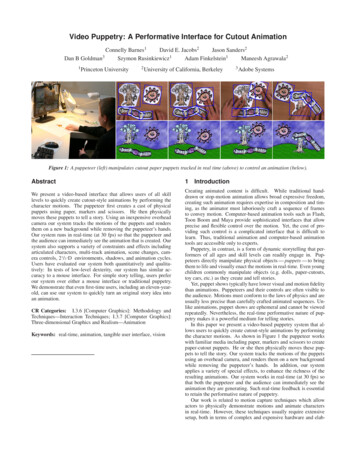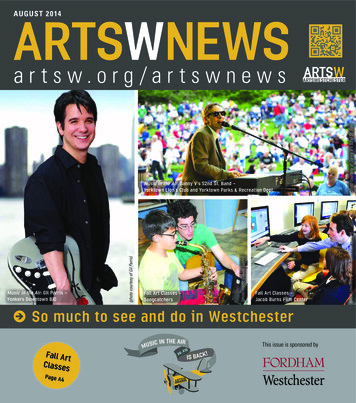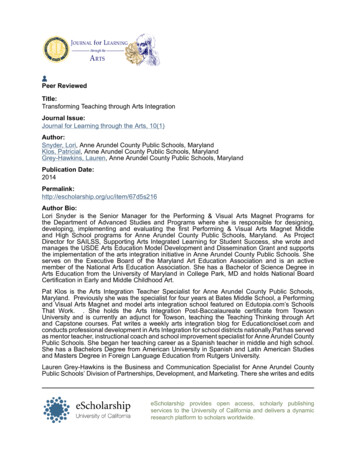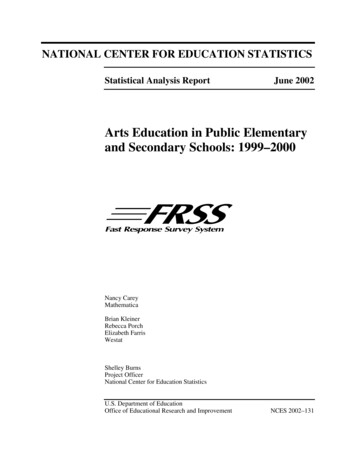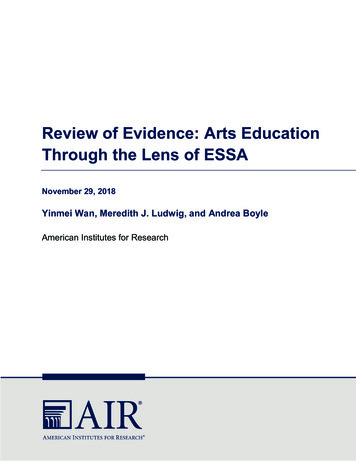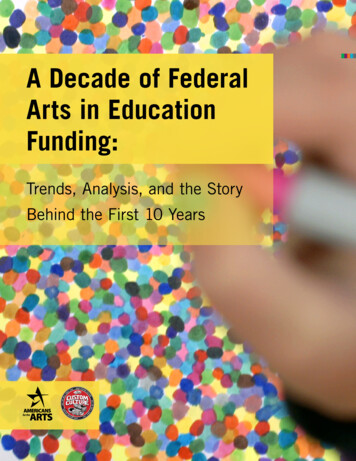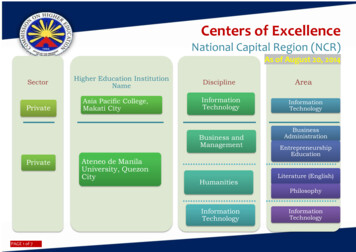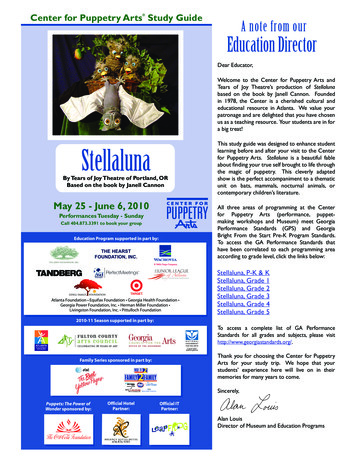
Transcription
Center for Puppetry Arts Study Guide A note from ourEducation DirectorDear Educator,Welcome to the Center for Puppetry Arts andTears of Joy Theatre’s production of Stellalunabased on the book by Janell Cannon. Foundedin 1978, the Center is a cherished cultural andeducational resource in Atlanta. We value yourpatronage and are delighted that you have chosenus as a teaching resource. Your students are in fora big treat!This study guide was designed to enhance studentlearning before and after your visit to the Centerfor Puppetry Arts. Stellaluna is a beautiful fableabout finding your true self brought to life throughthe magic of puppetry. This cleverly adaptedshow is the perfect accompaniment to a thematicunit on bats, mammals, nocturnal animals, orcontemporary children’s literature.StellalunaBy Tears of Joy Theatre of Portland, ORBased on the book by Janell CannonMay 25 - June 6, 2010Performances Tuesday - Sunday Call 404.873.3391 to book your groupEducation Program supported in part by:THE HEARSTFOUNDATION, INC.Atlanta Foundation Equifax Foundation Georgia Health Foundation Georgia Power Foundation, Inc. Herman Miller Foundation Livingston Foundation, Inc. Pittulloch FoundationAll three areas of programming at the Centerfor Puppetry Arts (performance, puppetmaking workshops and Museum) meet GeorgiaPerformance Standards (GPS) and GeorgiaBright From the Start Pre-K Program Standards.To access the GA Performance Standards thathave been correlated to each programming areaaccording to grade level, click the links below:Stellaluna, P-K & KStellaluna, Grade 1Stellaluna, Grade 2Stellaluna, Grade 3Stellaluna, Grade 4Stellaluna, Grade 52010-11 Season supported in part by:To access a complete list of GA PerformanceStandards for all grades and subjects, please visithttp://www.georgiastandards.org/.Thank you for choosing the Center for PuppetryArts for your study trip. We hope that yourstudents’ experience here will live on in theirmemories for many years to come.Family Series sponsored in part by:IN YOUR LIFE. OFF YOUR MIND.Sincerely,Puppets: The Power ofWonder sponsored by:Official HotelPartner:Official ITPartner:Alan LouisDirector of Museum and Education Programs
Artist and writer Janell Cannon was born November 3, 1957.She always loved animals, especially creatures that tend tomake people uncomfortable. Ms. Cannon noticed thatcertain animals like bats, spiders and snakes are oftenfeared and therefore misunderstood or neglected. Whileconducting research about bats, she found only two bookson the subject, both out of print. She decided it was time tomake her own story about these wonderful creatures. Janellcreated Stellaluna in hopes that she would transform youngpeople’s fear of bats into informed affection. “Fruit bats don’tdrink blood and won’t get caught in your hair. I hope toshow them in a positive light so that they might be givenmore respect,” she says.The artist and writer also wanted totouch readers with a story about a friendship shared by twodifferent kinds of creatures, a bat and three baby birds. Ms.Cannon works from her home/studio in southern California,which she shares with a cat and a parrot.Photo by Cathy CannonAbout the AuthorJanell Cannon, author of StellalunaSynopsisStellaluna, the enchanting story of a baby fruit bat who falls into a bird’s nest, is adapted from the beloved book byJanell Cannon. Poor Stellaluna tries to adapt to her new home but finds herself the odd one out, hanging by her feetand disgusted by those bugs Mother Bird brings home for dinner. What a relief to discover she is a bat! This storycan be seen as a parable about children struggling to adapt to unfamiliar situations.Style of PuppetryStellaluna is performed by 2 skilled puppeteers who manipulate all of the puppets in the show and perform all of thecharacters’ voices live. Each puppeteer wears a cordless microphone to amplify her voice. Dressed in black fromhead to toe, the puppeteers move freely about the stage often in full view of the audience.Appropriate puppet manipulation is essential to a successful puppet show. Puppet builders often study the wayreal animals move in order to capture the essence of that movement on the puppet stage. For the bat puppets inStellaluna, the puppet builders created kite-like puppets that soar and dive like real bats. The puppeteers also use softsculpted rod puppets that have small sticks called control rods that are attached to different parts of a puppet’s body.By gripping a control rod and turning it, the puppeteer can make a puppet turn its head to focus its attention in anydirection, flap its wings, fly and hang upside down.About the CompanyFounded in 1971, Tears of Joy Theatre of Portland, Oregon, is recognized as one of the nation’s outstanding puppetcompanies, with three of the theatre’s productions having received UNIMA-USA’s Citation of Excellence in the Artof Puppetry, American puppetry’s highest honor. The company has also received a Washington State Governor’s ArtsAward and a Young Audiences Sunburst Award for exemplary commitment to arts in education. Tears of Joy toursto schools and theaters throughout the U.S., performing for over 200,000 people each year. The theatre is also aresident company at the Portland Center for the Performing Arts. 2010 Center for Puppetry Arts . All Rights Reserved.2
Bibliography Appelt, Kathi. Bat Jamboree. HarperCollins Books, 1998. Appelt, Kathi. Bats Around the Clock. HarperCollins Books, 2000. Bash, Barbara. Shadows of the Night: The Hidden World of the Little Brown Bat. Sierra Club Booksfor Children, 1993. Berger, Melvin. Scholastic Q & A: How Do Bats See in the Dark? Scholastic Reference, 2001. Cannon, Janell. Crickwing. Harcourt Children’s Books, 2000. Cannon, Janell. Pinduli. Harcourt Children’s Books, 2004. Cannon, Janell. Stellaluna. Harcourt Children’s Books, 1993. Cannon, Janell. Trupp: A Fuzzhead Tale. Harcourt Children’s Books, 1995. Cannon, Janell. Verdi. Harcourt Children’s Books, 1997. Cole, Joanna. The Magic School Bus Going Batty: A Book About Bats. Scholastic Paperbacks, 1996. Davies, Nicola. Bat Loves the Night. Candlewick Books, 2004. Earle, Ann and Henry Cole. Zipping, Zapping, Zooming Bats. HarperCollins Books, 1995. Glaser, Linda. Beautiful Bats. Millbrook Press, 1998. Graham, Gary L. Bats of the World. Golden Guides from St. Martin’s Press, 2001. Hall, Leslie and Greg Richards. Flying Foxes: Fruit and Blossom Bats of Australia. Krieger PublishingCompany, 2001. Kaufmann, John. Bats in the Dark. Thomas Y. Crowell Company, 1972. Lies, Brian. Bats at the Beach. Houghton Mifflin, 2006. Lunde, Darrin. Hello, Bumblebee Bat. Charlesbridge Publishing, 2007. MacLulich, Carolyn. Bats. Scholastic Books, 1999. Steele, Philip. Vampire Bats and Other Creatures of the Night. Kingfisher Books, 1995. Tuttle, Merlin D. America’s Neighborhood Bats. University of Texas Press, 1988. 2010 Center for Puppetry Arts . All Rights Reserved.3
Internet s/AnimalsNature/Bat-caveCheck out National Geographic’s Amazing Bats of Bracken Cave to learn about the famous MexicanFree-tailed Bats of Austin, tmLearn about Flying Foxes on Bellingen Island, Australia.http://www.batcon.org/Visit Bat Conservation International online for a wealth of information about bats.www.batworld.orgExplore a wealth of information about bats at Bat World!http://www.eparks.org/pdf/batbox.pdfLearn how to build a bat box courtesy of Mammoth National ature7/online extra.htmlExperts are debunking myths about bats in this enlightening online article.http://www.bats4kids.org/There are bats, bats everywhere at aluna.phpCheck out Home School Share.com for Stellaluna learning activity ne.htmlExplore the Bat Zone at Cranbrook Institute of Science, Bloomfield Hills, ls/bat/label/external/Label the external parts of a bat on this printable diagram.4
Learning ActivitiesP-K & K:Comparing Bats and BirdsGeorgia Bright from the Start Pre-K Content Standards covered: Language and LiteracyDevelopment, LD 3 a (increases vocabulary through everyday communication); Scientific Development,SD 2 a (observes, explores and describes a wide variety of plants and animals). Georgia PerformanceStandards covered: Kindergarten, ELAKLSV1 e,f ; SKL1 b; SKL2 a.Objective: Students will compare and contrast a bat and bird (using pictures set side by side), givingexamples of how they are alike and different. Students will then color their pictures.Materials: Bat and bird coloring sheets from this study guide (courtesy of www.thecoloringspot.com),crayons, chart paper, markers.Procedure:1. After attending a performance of Stellaluna at the Center for Puppetry Arts, reproduce the batand bird coloring sheets so that every student has one.2. Distribute bat and bird coloring sheets to the class. Ask students to compare them.3. On the board or on a piece of chart paper, draw two overlapping circles (a Venn diagram). Labelone circle “bats” and the other circle “birds.” Label the part where the circles overlap “both.”4. First ask students to give as many examples as they can of how they are different (one is amammal, one lays eggs, one hangs upside down, one has feathers, one has fur, one is nocturnal).List each animal’s unique qualities under their names on the diagram.5. Then ask students to give as many examples as they can of how they are alike (both have wings,both have eyes, both can fly, both eat insects). List the similarities that the birds share in thespace where the circles overlap labeled “both.”6. When they are done comparing the two animals, ask students to color their sheets.Assessment: Monitor student responses for accuracy. After a few weeks have passed, ask students torecall the similarities and differences between bats and birds. Repeat this activity with different animalsso that students become accustomed to comparing and contrasting. 2010 Center for Puppetry Arts . All Rights Reserved.5
Name Date6
Learning Activities1st & 2nd Grade: Bat Math: Comparing ValuesGeorgia Performance Standards covered: Grade 1, Mathematics, Number and Operations,M1N1 c; Grade 2, Mathematics, Number and Operations, M2N5 a.Objective: Students will compare two sets and determine if the value of the first set is less than,greater than, or equal to the value of the second set.Materials: Student handouts from this study guide, pencils.Procedure:1. Review the signs for less than , greater than and equal to , with your students.2. Have students create sets that are equal and unequal using math manipulatives.3. Distribute student handouts. Ask students to compare the sets of bats to determine if the firstset is less than, greater than, or equal to the second set. Ask students to write the correct signin the blank for each set.Photo by Nancy AldrichAssessment: Check students’ work for accuracy.Puppets from Stellaluna 2010 Center for Puppetry Arts . All Rights Reserved.7
Name DateComparing ValuesDirections: Compare each set of bats. Are the sets equal or unequal? Fill in each blank with a , or sign.1.2.3. 2010 Center for Puppetry Arts . All Rights Reserved.8
Learning Activities3rd & 4th Grade: Research Your Favorite Type of BatGeorgia Performance Standards covered: Grade 3, English/Language Arts (ELA), Writing, ELA3W1.Grade 4, Language Arts, Written Communication (Reading): 13, 16, 17, 21; (Writing): 39, 40, 41. SocialStudies, Core Social Studies Skills (Information Processing): 24, 25, 26, 36. Georgia PerformanceStandards covered: Grade 4, English/Language Arts (ELA), Writing, ELA4W2.Objective: Students will select a type of bat to research and then write a report on their findings.Materials: Paper, pencils, computers with Internet access, access to school media center and/or publiclibrary.Procedure:1. Prewriting. Teacher should guide students through a brainstorming session to list different typesof bats such as Mexican Long-tongued Bat, Spotted Bat, California Leaf-nosed Bat, Red Bat,YumaBat, Cave Bat, Big-Eared Bat, Brown Bat, Fruit Bat, etc.2. Research. Ask each student to select a type of bat that they would like to learn moreabout. Once they have chosen a bat to research, they should locate books, encyclopedias,digital media and websites on the Internet to gather information about their species. Theymay also conduct an interview with a chiroptologist in person, email or by telephone.3. Drafting. Students should use research finding to complete the first draft. Ask students toaddress the following points: How did your bat get its name?Describe your bat’s appearance.How much does your bat weigh?What is the width of your bat’s wingspan?How long is your bat’s body?In what part of the world is your bat found?In what sort of habitat does your bat live?What foods make up your bat’s diet?Is your bat on the endangered species list?4. Revising and editing. Have students prepare a first draft of their report for editing.5. Publishing. Final drafts should be presented before the class.Assessment: Check student work for completeness. Quiz students on questions from thereading after a few weeks have passed to see if they have retained the information given in theinformational paragraph. 2010 Center for Puppetry Arts . All Rights Reserved.9
Learning Activities5th & 6th Grade: Anatomy of a BatGeorgia Performance Standards covered: Grade 5, Science, Life Science S5L1 a;Grade 6, Science, Habits of the Mind S6CS5 b.Objective: Students will identify and label the external parts of a bat on a diagram.Materials: Student handouts from this study guide, and pencils or pens. Students may use a reference bookor the internet if necessary.Procedure:1. Distribute bat anatomy sheets to students. Ask students to label the following 9 parts of a bat ontheir sheets: body – a bat’s body is covered with fur. ears – bats have large ears and excellent hearing. Carnivorous bats have larger ears thanherbivorous bats. Carnivorous bats have echolocation abilities. arm bones – a bat’s arms consist of an upper arm (humerus) and a forearm (with a radiusand reduced ulna) with an elbow between them. eyes – bats have good eyesight. They can see very well in the dark. five-toed feet – bats have two, five-toed feet and short legs with knees. Bats sleep upsidedown, hanging by the claws on their toes. nose – most bats have a good sense of smell. thumb – a bat’s clawed thumb is very short (unlike the other four fingers which are very long). uropatagium – is the flap of skin between a bat’s hind legs and the tail. wings – bats have large wings supported by their arm and finger bones. The wings arecovered with leathery skin called the patagium. A bat’s wings are powered by largemuscles in the body. Bats are the only flying mammal.Assessment: Check student’s work for completion and accuracy.Center for Puppetry Arts is a non-profit, 501(c)(3) organization and is supported in part by contributions from corporations, foundations, government agencies, and individuals. Major funding for the Center is provided by the Fulton County Board of Commissionersunder the guidance of the Fulton County Arts Council. Major support is provided by the City of Atlanta Office of Cultural Affairs.Thisprogram is supported in part by the Georgia Council for theArts (GCA) through the appropriations from the Georgia GeneralAssembly.GCA is a Partner Agency of the National Endowment for the Arts.The Center is a Member of Theatre Communications Group (TCG)and the Atlanta Coalition of Performing Arts.The Center also serves as headquarters of UNIMA-USA, the American branch of UnionInternationale de la Marionnette, the international puppetry organization.10
Name Date11Illustration by Anthony Owsley 2010 Center for Puppetry Arts . All Rights Reserved.
Study Guide Feedback Form The following questions are intended for teachers and group leaderswho make use of the Center for Puppetry Arts’ study guides.1. In what grade are your students?2. Which show did you see? When?3. Was this your first time at the Center?4. Was this the first time you used a Center Study Guide?5. Did you download/use the guide before or after your field trip?6. Did you find the bibliography useful? If so, how?7. Did you find the list of online resources useful? If so, how?8. Did you reproduce the grade-appropriate activity sheet for your class?9. Additional information and/or comments:Please fax back to the Center for Puppetry Arts at 404.873.9907.Your feedback will help us to better meet your needs. Thank you for your help!1404 Spring Street, NW at 18th Atlanta, Georgia USA 30309-2820Ticket Sales: 404.873.3391 Administrative: 404.873.3089 www.puppet.org info@puppet.orgHeadquarters of UNIMA-USA Member of Atlanta Coalition of Performing Arts and Theatre Communications GroupText by Alan Louis & Tears of Joy Theatre Design by Melissa Hayes Center for Puppetry Arts Education Department, March 2010.
Aug 18, 2019 · Appropriate puppet manipulation is essential to a successful puppet show. Puppet builders often study the way real animals move in order to capture the essence of that movement on the puppet stage. For the bat puppets in Stellaluna, the puppet builders created kite-like puppets that s
